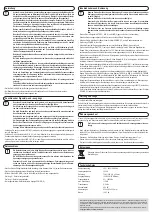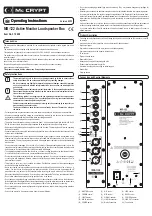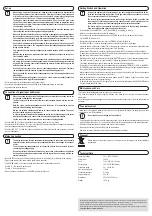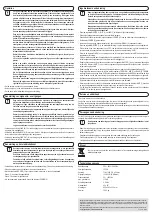
Set-up
When setting it up with other equipment, make sure that the appliance is well ventilated.
Keep a suf
fi
cient distance from heat sources. Do not place the active monitor loudspeak-
er in the direct vicinity of heat sources, such as a heater. Do not point any strong beams
or light sources onto the device. This may cause overheating (risk of
fi
re!).
The device’s heat dissipation must not be obstructed. Do not cover the back of the
device. The air circulation must not be obstructed by objects such as magazines, table-
cloths, curtains or similar. This prevents heat dissipation from the device and can lead
to overheating (risk of
fi
re).
Do not drill any additional holes or screw any additional screws into the housing, since
this could make contact with dangerous voltages possible.
Make sure that the connection cable is not pinched or damaged by sharp edges. Always
lay the cables so that nobody can trip over or become entangled in them. Risk of injury.
The cables must be suf
fi
ciently long. Avoid mechanical strain on the cables. This may
damage the cables or the device. There is a danger of fatal electric shock.
Do not place the active monitor loudspeaker in the direct vicinity of screens, such as TV
sets or computer monitors. The magnetic
fi
eld from the loudspeakers might distort the
image on such devices.
Only operate the active monitor loudspeaker on a stable surface, which is not sensitive
to heat.
When setting up the device, make sure that it has a stable base and that the set-up loca-
tion is suitably stable.
If you install the active monitor loudspeaker at an elevated position or stack loudspeak-
ers on top of one another, the loudspeakers must be secured with appropriate securing
devices. When so doing, ensure that the fastening material and the anchoring area are
suf
fi
ciently dimensioned.
Serious injury to persons can be caused if the loudspeaker box falls down. Therefore,
the loudspeaker must be secured by experienced and trained personnel.
Do not suspend the active monitor loudspeaker box from the carrying handles or any
other
fi
ttings.
If the active monitor loudspeaker is set up on a stand it must be suitably robust and
appropriate for the weight of the loudspeaker.
• Set up the active monitor loudspeaker at the desired location.
• If necessary, a loudspeaker stand can be inserted in the loudspeaker
fl
ange on the bottom.
• Align the sound outlet as desired.
Connection of Signal Input and Output
When connecting the signal input and output, make sure that the connection cables are
not pinched or damaged by sharp edges.
The inputs may only be connected to low-level audio outputs of audio devices or micro-
phones.
Both the active monitor loudspeaker box and the device it is connected to must be
switched off while making the connection.
Always use suitably shielded audio cables to connect inputs and outputs. The use of
incorrect cables may lead to interference.
In order to prevent distortion and mismatching, which could cause damage to the active
monitor loudspeaker, only connect audio devices with appropriate outputs.
Lay the connection cables so that they do not present a tripping hazard.
• Connect LINE IN (11) to the pre-ampli
fi
er of the upstream audio device (e.g. mixer).
• Connect the MIC IN connector (10) to your microphone. Dynamic microphones and capacitor microphones
with own voltage supply may be connected here.
• Connect LINE OUT (12) with the input of another device that will receive the same signal as the active
monitor loudspeaker.
Mains Connection
The mains socket to which the active/monitor loudspeaker is connected, must be easily
accessible so the device can be quickly separated from the mains voltage in the case of
a fault.
The active monitor loudspeaker and all connected devices must be turned off when
connecting the voltage supply.
Ensure that all the electrical connections and connection cables between the different
devices and any extension cables comply with the regulations and comply with the op-
erating instructions.
• Insert the IEC connector on the mains cable into the mains connection (14) at the back of the housing.
• Plug the power plug of the power supply cable into a wall socket.
• The POWER switch (13) is used to switch the active monitor loudspeaker on and off.
Position “O”: The device is switched off.
Position “I”: Device is turned on.
• When the device is switched on, the POWER indicator (9) lights up.
Getting Started and Operation
Only put the appliance into operation when you have familiarised yourself with its fea-
tures and these operating instructions. Check again that all the connections are correct.
Do not operate the product if it is damaged.
The active monitor loudspeaker should always be the last to be turned on and the
fi
rst
to be turned off. In this way you prevent any undesired noise, which typically can occur
when switching off a mixer, from damaging the active monitor loudspeaker.
The device may only be operated by persons familiar with the operating instructions.
Keep other persons and children away from the device.
• Turn down the controls MASTER (1), MIC (2) and LINE (3) completely (to the left).
• Switch on the connected mixer and start the playback.
• Turn on the active monitor loudspeaker using the POWER switch (13) on the back of the housing.
• The POWER (9) indicator is lit.
• If a signal has been recognised at the input, the SIGNAL indicator (8) lights up.
• Turn the MASTER (1) control to the middle position in the
fi
rst third of the control range.
• Adjust the volume on the mixer to about 75% of the maximum volume or to the maximum undistorted level
(visible on devices with recording level displays and “0 dB” labelling).
• Now turn the LINE control (3) clockwise until the signal is distorted. Then turn the control back slightly.
• To adjust the microphone input, turn the MIC control (2) clockwise until the microphone volume corresponds
approximately to the volume of the mixer signal.
• Adjust the volume of the active monitor box, with the MASTER control (1), to the maximum desired volume.
The LIMIT indicator (7) should only light up brie
fl
y. If it lights permanently, the volume is set too high.
• This setting enables a high signal-to-noise ratio and provides the best audio quality.
• Control the sound of the active monitor loudspeaker with the controllers TREBLE (4), MID (5) and BASS
(6). TREBLE controls the treble, MID the mid range and BASS the bass range. Turning clockwise increases
the volume of the corresponding frequency range and vice-versa.
• After this basic setting, the volume is set by using just the volume control on the mixer. The set-up procedure
needs to be repeated with every change to the circuit.
• If the active monitor box is overloaded at volume peaks, the LIMIT indicator (7) lights up and the inbuilt
ampli
fi
er reduces the output to prevent damage.
• To switch the complete system off,
fi
rst switch off the active monitor loudspeaker with the POWER switch
(13) and then switch off the mixer.
Maintenance and Care
The active monitor loudspeaker does not require any maintenance.
Only clean the outside with a dry or slightly moistened cloth. Make sure not to touch the sensitive speaker
membranes.
Never use aggressive cleaning agents or chemical solutions as the carpet cover or the membrane could be
damaged.
Fuse replacement
If fuses have to be changed, make sure that they are only replaced with fuses of the same type and rated
current (refer to the “Technical Data”).
Do not repair fuses or bridge the fuse holders.
• Only unplug the IEC connector from the mains connection (14) on the device after disconnecting it from the
mains (unplug at the socket) . Pry out the fuse holder (15) with the defective fuse on the mains connection.
• Remove the defective fuse and replace it with a fuse of the same type.
• Now, carefully replace the fuse holder (15) with the new fuse.
• Afterward, reconnect the mains cable to the device and plug into a socket.
Disposal
Please dispose of the product, when it is no longer of use, according to the current statutory
requirements.
Technical Data
Operating voltage
220 – 240 V/50-60 Hz
Power input
150 VA
Fuse
T1 AL/250 V (5 x 20 mm)
Output power
100 / 200 W (RMS/max.)
Frequency range
50 – 19,000 Hz
max. sound pressure
115 dB
Crossover frequency
2.5 kHz
Angle of radiation
90 x 60°
Dimensions
635 x 385 x 355 mm
Weight 19.25
kg
These operating instructions are a publication by Conrad Electronic SE, Klaus-Conrad-Str. 1, D-92240 Hirschau (www.conrad.com).
All rights including translation reserved. Reproduction by any method, e.g. photocopy, micro
fi
lming, or the capture in electronic data
processing systems require the prior written approval by the editor. Reprinting, also in part, is prohibited.
These operating instructions represent the technical status at the time of printing. Changes in technology and equipment reserved.
© Copyright 2012 by Conrad Electronic SE.


























